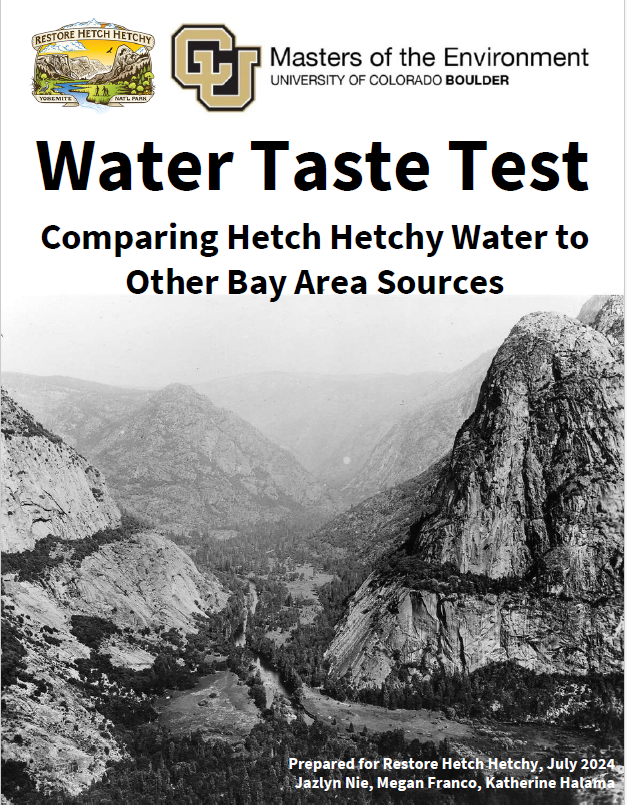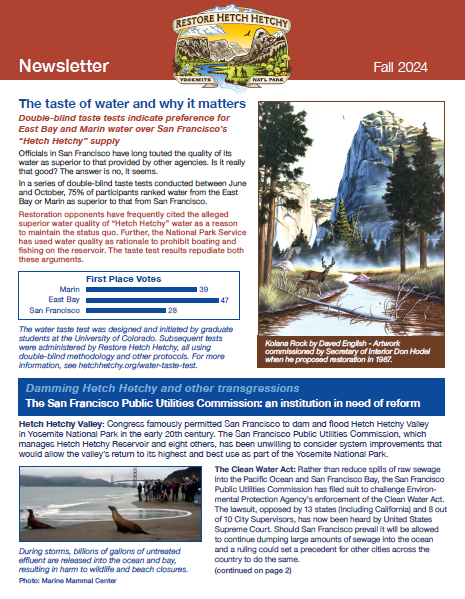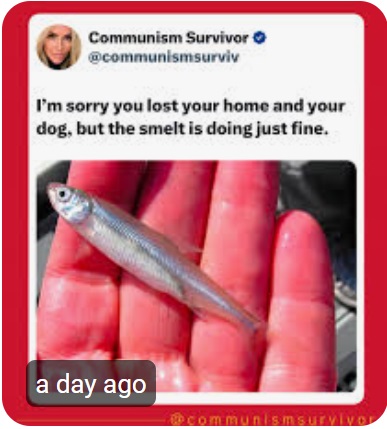
by Spreck | Jan 11, 2025 | Uncategorized
As devastating fires in Los Angeles continue to burn, too many politicians and keyboard warriors are making irresponsible assertions about the causes of the fires and the challenges of fighting them. It’s far from the first time that such nonsense has been used to promote political agendas – the 1906 (earthquake and) fire that devastated San Francisco was used to justify damming Hetch Hetchy Valley in Yosemite National Park.
Some of the blame for the fires that have obliterated Pacific Palisades and Altadena has fallen on the endangered Delta smelt. It’s true that exports of water from northern California to farms and cities in the south have been reduced at times to protect smelt and other fisheries. Large reservoirs in southern California, however, have plentiful supplies; there is no regional lack of water to fight the fires. (This Wall Street Journal video explains why some fire hydrants did run dry.)

One of the least obnoxious, but still wholly inaccurate, memes blaming the Delta smelt for fire damage.
A century ago, the lack of water available to fight the devastating fire that erupted following the San Francisco earthquake on April 18,1906 was used to justify damming Hetch Hetchy Valley in Yosemite National Park. (Again, local reservoirs had plentiful supplies, but water mains in the city were severed by the earthquake.)

With water mains broken throughout the city, there was little firefighters could do to quell the inferno.
For example, Senator Henry Myers (Montana) read the following before the U.S. Senate on December 1, 1913 as it was debating the Raker Act:

Senator Henry Myers (MT)
“Their fair city has been decimated by earthquake and fire and it has been reported on credible authority that one of the greatest causes of the devastation to that fair city was lack of adequate water supply – they very thing they are trying to get today at a cost of millions of dollars to the taxpayers.”
The broken water mains were operated by the Spring Valley Water Company, a private enterprise that had long frustrated City officials. Had a public water system been in place, there is no indication the pipes would have better endured the powerful earthquake. For more information about how the proposal to dam Hetch Hetchy came to fruition after having been rejected twice by the federal government and abandoned by the San Francisco Board of Supervisors, see Hetch Hetchy, the Earthquake and the Boodle.
There are very hard lessons to be learned from yet another year of terrible fires. What could and should have been done differently and more importantly, what must we do moving forward. Blaming fires on red herrings such as Delta smelt won’t help the thoughtful planning that is necessary to help us avoid these catastrophes.

by Spreck | Jan 11, 2025 | Uncategorized
It’s always great to see elected officials take an interest in improving the situation at Hetch Hetchy.
Congressman Tom McClintock, whose district includes Yosemite, has introduced H.R. 177, legislation intended to improve access and recreation at Hetch Hetchy as well as to increase the fees that San Francisco pays for storing water in a national park.
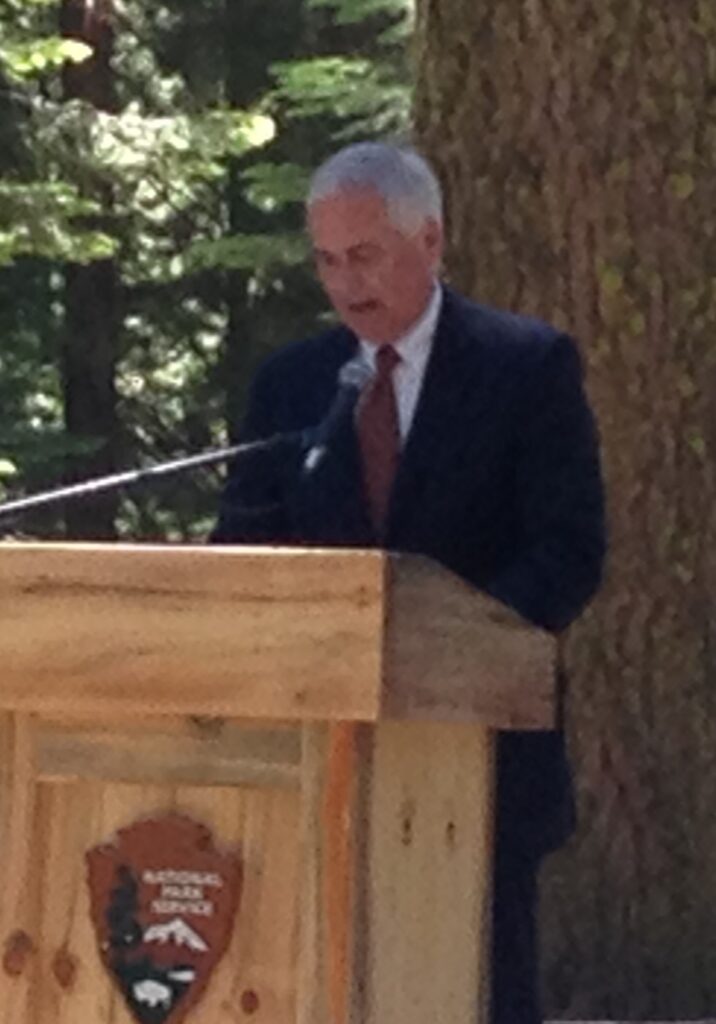
The bill is cosponsored by Reps. David Valadao, Ken Calvert and Doug LaMalfa. At this point there is no text associated with the proposal. Note that Rep. Connie Conway introduced a similar bill, the Yosemite National Park Equal Access and Fairness Act, in 2022, which Rep. McClintock reintroduced in 2023.
Will the third time be a charm?
The mandate to improving access at Hetch Hetchy, even with the dam in place, was explored in Keeping Promises: Providing Public Access to Hetch Hetchy Valley, Yosemite National Park (Restore Hetch Hetchy, 2021). Since that time, we have been working with the National Park Service to improve access, including fishing, boating and camping – activities expected by Congress when it passed the Raker Act in 1913 but which have never been made available. The NPS has been sympathetic to our requests but reluctant to make changes.
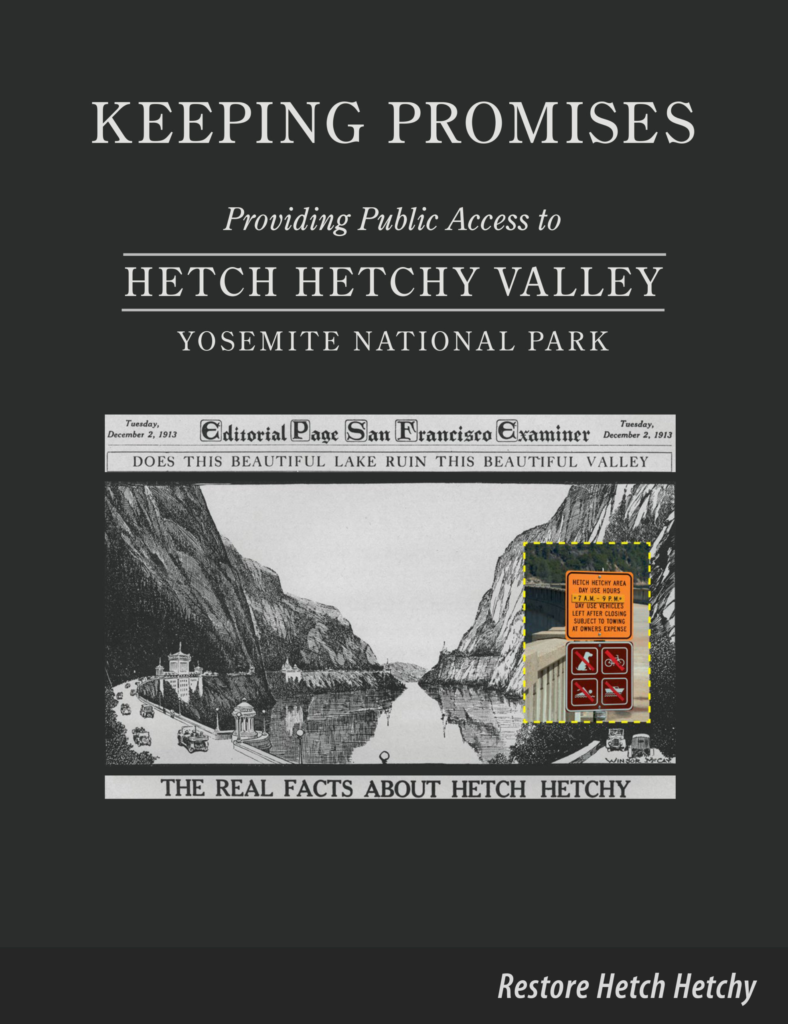
So, we are pleased to see that legislation is again being considered. Any final endorsement will depend on the details of the legislation.
We have been in contact with Rep. McClintock’s staff on issues of improved recreation and our shared view that the visitor experience at Hetch Hetchy warrants improvement. We do not, however, share common ground on the ultimate restoration of the valley. Rep. McClintock remains opposed to restoration, as far as we know, but we hope he will keep an open mind if a fair and cost effective plan to ensure no loss of water and power is put before him.
It’s far easier to introduce legislation than to pass it. But we do hope H.R. 177 will move forward in the current Congressional session.
We’ll keep you posted.

by Spreck | Dec 15, 2024 | Uncategorized
Most of California’s largest urban water systems have invested in groundwater recharge programs in rural regions. Restore Hetch Hetchy’s Yosemite’s Opportunity provides a list of some of these programs totaling up to 1,875,000 acre-feet of water storage – or more than 5 times the size of Hetch Hetchy Reservoir’s 360,000 acre-feet. Many of these cooperative programs involve agricultural lands near the California Aqueduct in Kern County where it is convenient for water agencies to exchange supplies.
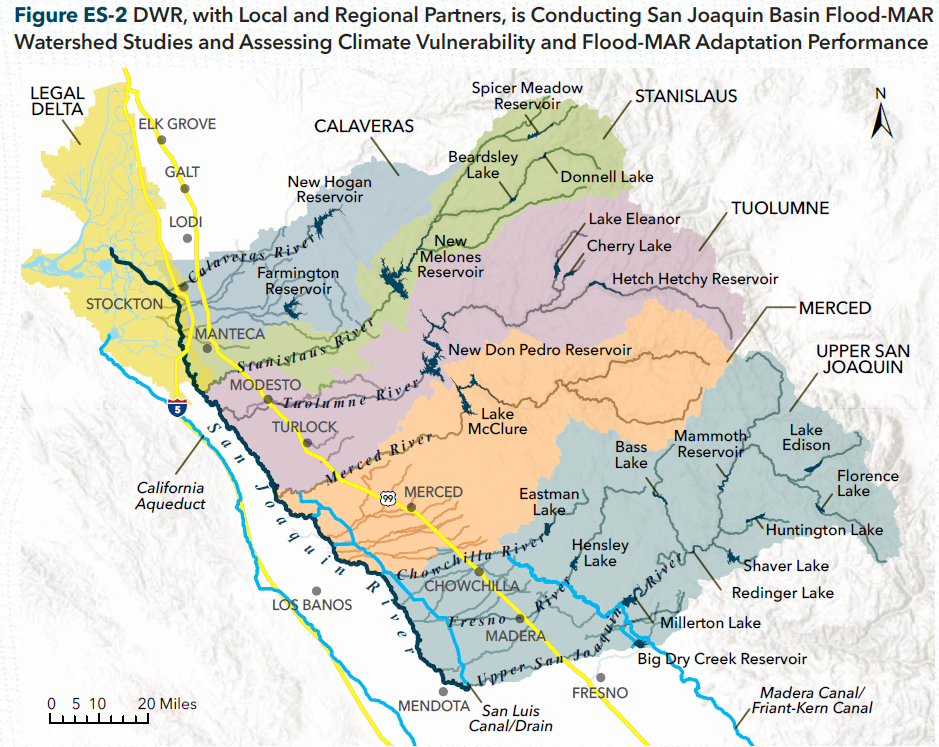
The California Department of Water Resources is conducting studies in each of the principal San Joaquin Valley watersheds to show how cooperative management can improve water supplies and groundwater levels while reducing flood. Restore Hetch Hetchy has been critical of San Francisco for declining to participate. Might the SFPUC change its mind?
Restore Hetch Hetchy has been sharply critical of the San Francisco Public Utilities Commission for not pursuing similar programs in Stanislaus County, where the Turlock and Modesto Irrigation Districts share the Tuolumne River and Don Pedro Reservoir and where there are ample opportunities to recharge groundwater that could provide widespread benefits. (We do give San Francisco credit for its groundwater banking program in San Mateo County – see below)
Our goal, of course, is to encourage San Francisco to improve its system so that Hetch Hetchy Valley can be restored! Others would like San Francisco to be less stingy with releases to sustain salmon populations in the lower Tuolumne River and downstream through the Delta and into the ocean. Businesses and residents in San Francisco and neighboring counties might prefer simply to have an increased buffer against drought. While these policy objectives differ, no reasonably informed person can deny that recharging groundwater in wet years has the potential to add cost-effective water supply.
Restore Hetch Hetchy has been particularly critical of the SFPUC for declining to even take part in the “Managed Aquifer Recharge” (aka Flood-MAR) studies being conducted by the California Department of Water Resources. We have made this point directly to the SFPUC and included it in our Fall Newsletter.
So we were pleased that the SFPUC did include DWR’s Flood-MAR studies in a meeting with the Bay Area Water Stewards last week. DWR staff presented their methodology and results of their initial study of the Merced River watershed. DWR will be extending its work to other Sierra watersheds, and we are hopeful it will produce useful results suggesting how flood waters from all rivers, including the Tuolumne, could be better managed.
The Flood-MAR studies are just studies (and be forewarned they are not designed for the casual reader) . They provide information and do not require any action. But that information can demonstrate how water agencies can better work together to manage water more effectively. So kudos to DWR for undertaking this effort. We hope San Francisco will join other water agencies throughout the state and learn what benefits might be achieved through restoration.
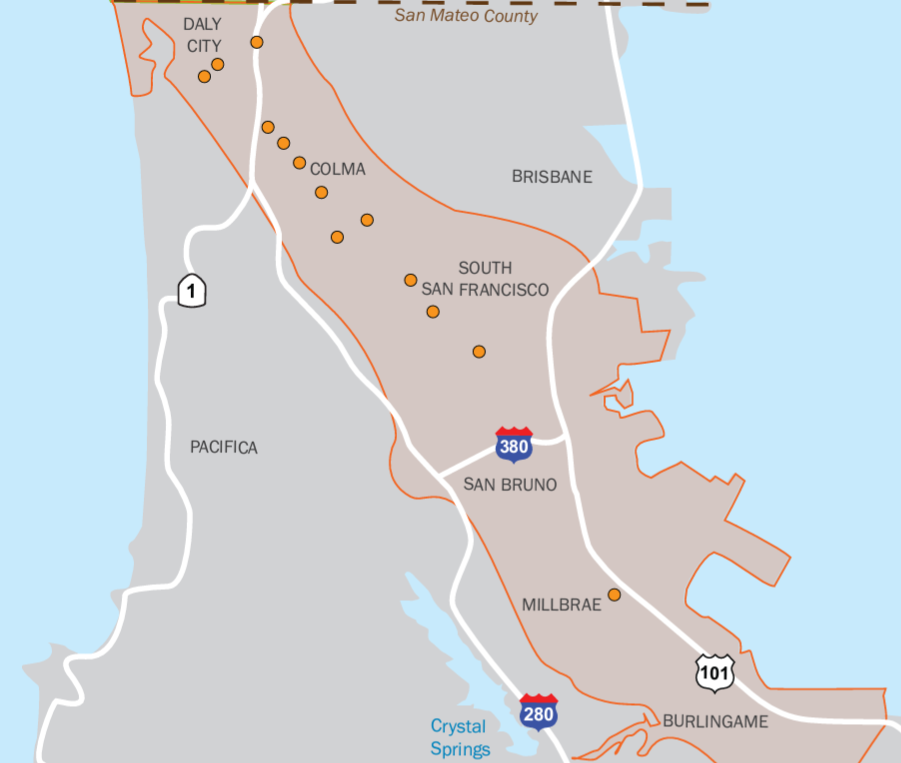
The SFPUC does deserve credit for working with cities in San Mateo County to recharge about 60,000 acre-feet of groundwater capacity. Essentially the cities will use surface water in wet years, allowing the aquifer to recharge (“in-lieu”). If and when a drought occurs, the SFPUC can extract these stored supplies for all customers.

by Spreck | Nov 26, 2024 | Uncategorized
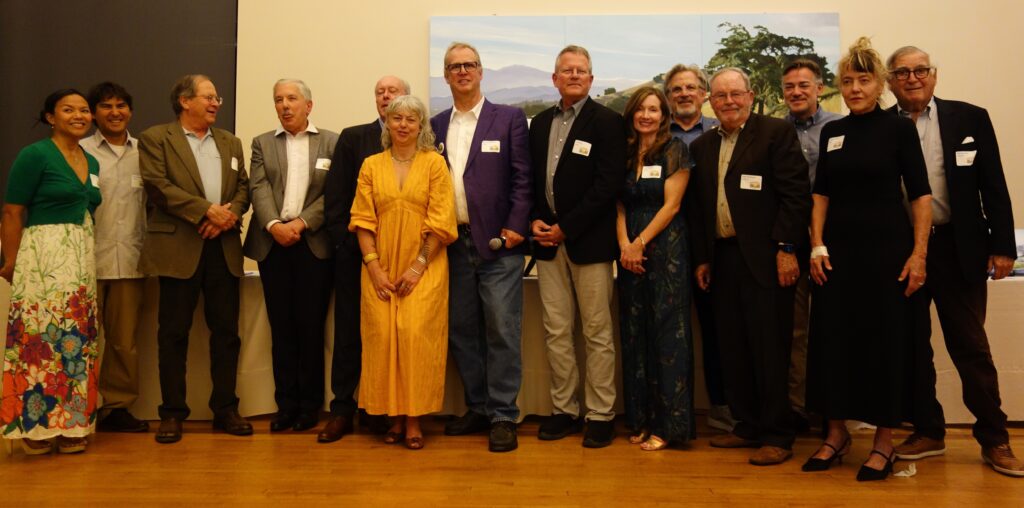
Tom Philp with the board and staff of Restore Hetch Hetchy
As Pulitzer Prize winner Tom Philp proclaimed at our Annual Dinner last month, “The highest and best use of Hetch Hetchy Valley is still restoration.”
Please consider a contribution so Restore Hetch Hetchy can continue our work – in Yosemite, in San Francisco, in Sacramento and in Washington D.C. – to make restoration a reality.
Restoring Hetch Hetchy to its natural splendor will create new homes for wildlife, provide park visitors an alternative to often overcrowded parts of Yosemite, and inspire a new generation to revere, protect and restore our most precious natural landscapes.
Thank you for supporting Restore Hetch Hetchy and Happy Holidays!

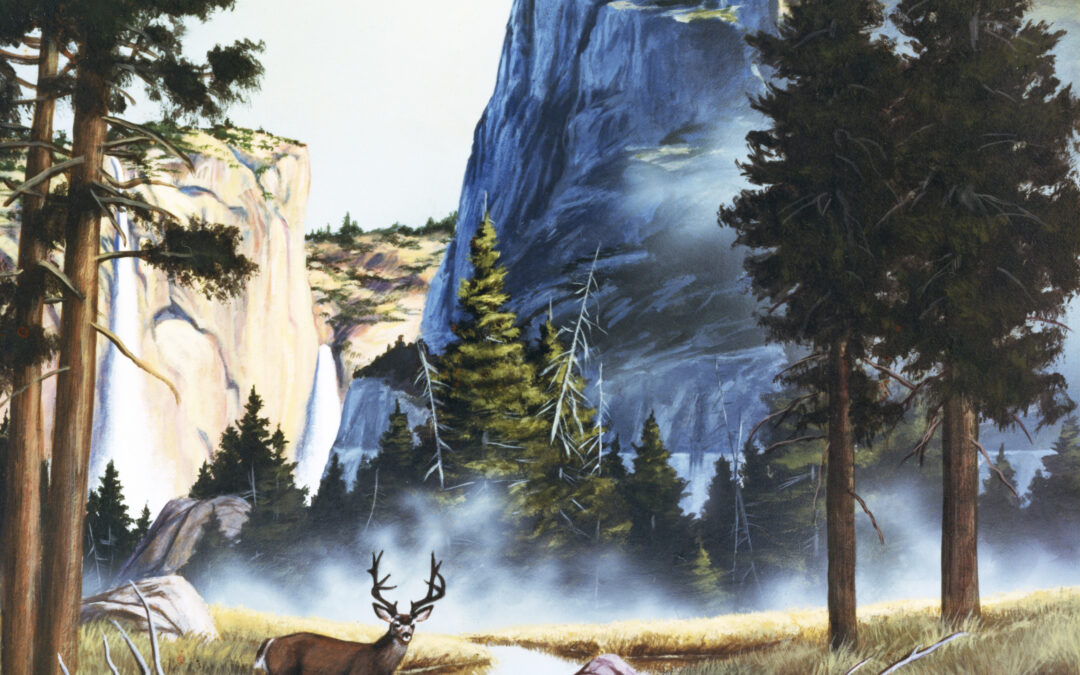
by Spreck | Nov 24, 2024 | Uncategorized
Our Fall 2024 Newsletter is out. If you’d like a printed copy but haven’t received one, send your name and address to admin@hetchhetchy.org.
We are pleased to share Daved English’s 1987 painting of Kolana Rock in a restored valley. Click the image for the full size – it is a big file.
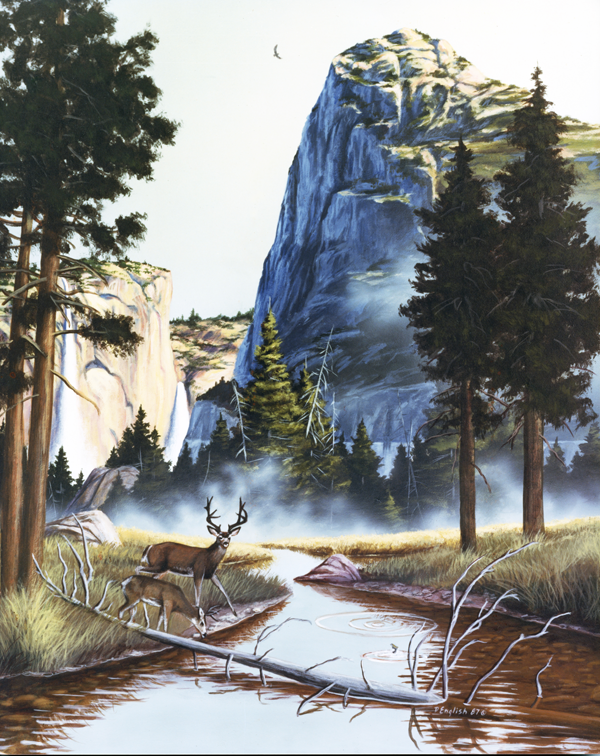
We respect the mission and work of agencies which serve water. Much of what the SFPUC does, however, is unacceptable. Restore Hetch Hetchy is dedicated to undoing their principal transgression of damming an iconic landscape in Yosemite National Park. In addition, the SFPUC has overhyped the taste of its water, sued the EPA for enforcing the Clean Water Act, refused to participate in Statewide groundwater recharge studies, and denied recreational access to most of its reservoirs. It truly is an institution in need of reform.
We are making progress encouraging the National Park Service to improve access to Hetch Hetchy. But we are also frustrated. In response to our advocacy, the NPS changed its rational but still prohibits boating and fishing at Hetch Hetchy (the largest reservoir in California where these activities are not allowed). We will not give up and are considering all our options.
Our Annual Dinner at the Lafayette Veterans Center was a ton of fun. Great to bring Tom Philp back into the fold. Salvador Lopez wowed the crowd when he described the love and labor that went into his gorgeous Hetch Hetchy painting. And it was very nice that every member of the board was able to attend – see photo below.

The Restore Hetch Hetchy Board – a dedicated, passionate and enthusiastic team – with staff and Tom Philp. Click image for full size.

by Spreck | Nov 3, 2024 | Uncategorized
The San Francisco Chronicle’s headline reads: “San Francisco’s famous water was put to a taste test. The results are surprising.” The full article is available online and well worth reading.
At Restore Hetch Hetchy, we were not so surprised with the results.
We’ve long thought that the adulation over the supposed superior quality of San Francisco’s water is unwarranted. So, over the past few months, Restore Hetch Hetchy initiated and conducted a series of “taste tests” to see what people think.
Participants were asked to compare San Francisco’s “Hetch Hetchy” water with supplies delivered by the East Bay Municipal Utilities District and the Marin Municipal Water District, and to rank them according to their preference. Ties were allowed.
Let’s cut to the chase. Out of 114 first place votes, only 28 people (25%) chose San Francisco’s water.

All testing used a “double-blind” protocol – i.e. neither the person tasting the water nor the person administering the test knew which sources corresponded with the samples. Further, all taps were flushed before filling glass bottles, and all samples were kept at room temperature.
The tests took place in 3 stages:
- In June, samples were collected at the SFPUC and EBMUD headquarters and from a Mexican restaurant in Larkspur (grouchy staff at the Marin Municipal Water District declined to provide samples for the test!). Graduate students from the University of Colorado, who designed the test as part of a “Capstone” project, collected the opinions of passersby at the Rockridge BART station in Oakland. The Capstone Team’s reports – both their Findings as well as their Methodology and Recommendations – are posted.
- In July, samples were collected from private homes in San Mateo County (90% SFPUC water), Oakland (EBMUD) and Fairfax (Marin). The samples were offered to passersby at Safeway and in homes. The samples were also sent to a lab for analysis – see results for SFPUC, EBMUD and Marin.
- In October, samples were collected from the same private homes in San Mateo County, Oakland and Fairfax. The water was offered to people attending Restore Hetch Hetchy’s Annual dinner on October 26 – as soon as they arrived and before they consumed any other food or beverage.
A breakdown of the results is provided below reflecting the variability of responses. Also, as the Chronicle article notes, the exact mix of sources in any utility’s supply varies over time and location (for example, San Francisco has recently taken Hetch Hetchy Reservoir offline in winter months so they can do maintenance on the Mountain Tunnel – something customers rarely notice).

Some water experts have indicated they prefer San Francisco’s water for its “pure” taste. Others have said that San Francisco’s water has too little taste and that they prefer water with a modest mineral content (mostly calcium and magnesium). Too much mineral content, as is the case with much of southern California’s water, is generally disfavored. Figure 2, below, compares the mineral content of the samples used in the taste tests with values reported in water supplies for San Diego, Los Angeles and Sacramento.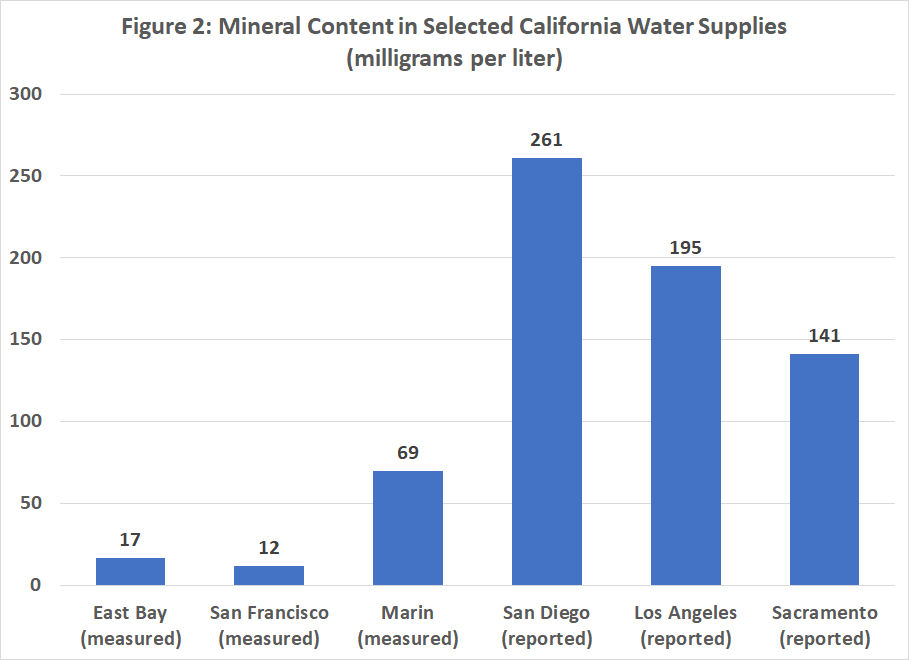
When Hetch Hetchy Valley is restored, San Francisco will still rely principally on the Tuolumne River for the majority of its supply. Water will be stored in and diverted from Cherry, Eleanor and Don Pedro Reservoirs – with mineral content perhaps similar to East Bay MUD’s Pardee Reservoir. Maybe customers will like their water even better!
Restore Hetch Hetchy is pretty well convinced that the hype over “Hetch Hetchy” water is overstated. If the San Francisco Public Utilities Commission is not convinced, we would welcome the opportunity to cosponsor an independent test.
*****************************************
Finally, a reminder that the Capstone Team will be presenting their Water Taste Test and other findings via Zoom Monday November 4 at 6 PM (Pacific Time). Register here if you would like to join the discussion.
